Click on images to enlarge
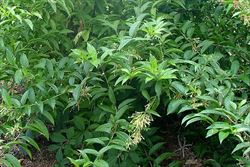
habit (Photo: Sheldon Navie)
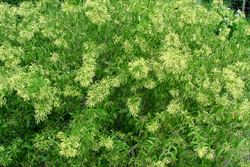
habit in flower (Photo: Sheldon Navie)
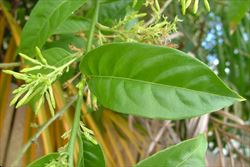
leaves and flower buds (Photo: Sheldon Navie)
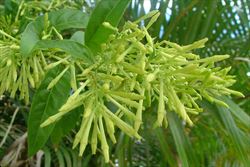
flower clusters (Photo: Sheldon Navie)
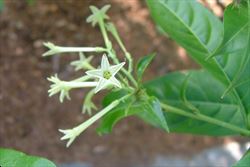
close-up of tubular flowers (Photo: Sheldon Navie)
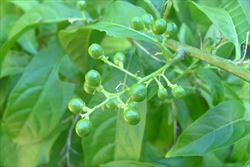
immature fruit (Photo: Sheldon Navie)
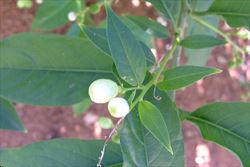
mature fruit (Photo: Sheldon Navie)
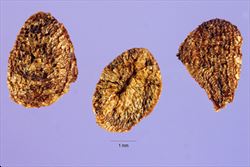
close-up of seeds (Photo: Steve Hurst at USDA PLANTS Database)
Scientific Name
Cestrum nocturnum L.
Synonyms
Cestrum graciliflorum Dunal
Cestrum leucocarpum Dunal
Cestrum multiflorum Roem. & Schult.
Cestrum nocturnum var. mexicanum O.E.Schulz
Cestrum propinquum M.Martens & Galeotti
Cestrum scandens Thibaud ex Dunal
Cestrum suberosum Jacq.
Chiococca nocturna Jacq.
Family
Solanaceae
Common Names
evening scented jessamine, jessamine, lady of the night, lady-of-the-night, night blooming jasmine, night cestrum, night jessamine, night queen, night-blooming jasmine, night-flowering cestrum, night-flowering jasmine, night-scented jasmine, queen of the night
Origin
Native to Mexico, Central America (i.e. Belize, Costa Rica, El Salvador, Guatemala, Honduras, Nicaragua and Panama) and Cuba.
Cultivation
Cestrum nocturnum is widely cultivated in tropical areas for the strongly scented flowers.
Naturalised Distribution
Naturalised in the coastal districts of central and northern New South Wales and sparingly naturalised in south-eastern Queensland.
Also naturalised in southern USA, New Zealand and on several Pacific islands (i.e. Hawaii, Fiji, Tahiti, Samoa, the Cook Islands, Tonga and Guam).
Habitat
Cestrum nocturnum thrives in moist or wet forests, scrub and open areas (both natural and disturbed).
Cestrum nocturnum has already invaded wet forests and open areas on several islands in the Pacific region. In New Zealand, the species is able to form dense stands in the forest understorey, but it has also invaded open forests, forest margins, the sides of streams and shrublands.
The species has invaded similar areas in Australia and is reported to be naturalised in coastal areas of northern New South Wales.
Habit
This species forms an evergreen, upright and woody shrub or small tree; heights normally reach up to 4 m, however some individual specimens may reach 5 m.
Distinguishing Features
- an upright shrub or small tree up to 4 m high.
- the young twigs are sparsely finely hairy; the undersurface of the leaf midrib is finely hairy; the leaves have an unpleasant odour when crushed.
- the flowers are greenish white to cream coloured and are produced in terminal panicles or clusters; the flowers are very strongly perfumed (said to resemble the aroma of "sweet custard powder") and the perfume is released during the hours of early evening and then into the night.
- the fruits are long oval to globular berries that are at first green but then become white.
Stems and Leaves
The branches are somewhat flexuous (bending and twining) and are sparsely finely hairy (pubescent) with simple hairs. The smaller twigs especially, exhibit these hairs.
The leaves are long, elliptical and lanceolate (resembling a spear-head), 10-15 cm long and 4-7 cm wide; smooth and glossy with even margins. The mid-rib undersurface is finely hairy.
Flowers and Fruit
The flowers are produced at the ends of the branches where they occur as dense clusters of flowers on short stems that emerge from the junctions of the leaves and the twigs. The result is a densely crowded end cluster of both flowers and leaves. The flowers are tubular, greenish white to cream (there is a known yellow variety) and the top of the tube splits into five sharply pointed, triangular lobes or petals. The tubular section of the flower is 2-2.5 cm long and the opened flower at night is about 1-1.3 cm in diameter. The stamens and anthers are contained within the floral tube.
The fruits are berries, globose, at first green then becoming white, 8-12 mm diameter. There may be up to 10 seeds in a single fruit and each seed is about 4-5 x 2-2.5 mm.
Reproduction and Dispersal
This species reproduces by abundantly produced seeds which can remain dormant in the soil for many years. However it can also reproduce through accidental damage which has resulted in dispersed stem or root sections.
Environmental Impact
Night jessamine (Cestrum nocturnum) has a negative impact on native ecosystems because it can form dense, shady thickets that outcompete the native flora and thus it prevents natural regeneration. It grows quickly and reproduces by both cuttings and seeds. In Auckland (New Zealand) the species is considered a seriously invasive weed. Cestrum nocturnum has also invaded areas of some of the Pacific Islands where it has formed dense and virtually impenetrable thickets.
As a garden escape, Cestrum nocturnum has invaded land near Sydney (New South Wales) and it is also reported as present in areas of coastal northern New South Wales.
Other Impacts
All parts of Cestrum nocturnum are highly toxic and there are reports of livestock deaths in New Zealand through this species. There is a report of a child who ingested the green berries over several weeks, however although the symptoms were considerable with vomiting and bleeding, the child recovered. So far there are no reports of human deaths.
Management
Cestrum nocturnum infestation can be managed in two ways, physically and chemically. Physical control consists of hand pulling small plants and seedlings and this can be done all year round. These can be left on site to rot since they do not have the ability to commence any form of regrowth. Larger and woody plants must be destroyed because the stems have the ability to resprout. Any cleared site must be replanted rapidly because reinfestation can occur through the soil seed-bank.
Chemical control can be accomplished by cutting the plant down and painting the cut surface with a herbicide solution. This can be done all year round.
Similar Species
Red cestrum (Cestrum elegans) is also present in South East Queensland, however this species has showy, bright red clusters of flowers.
Notes
This shrub has invaded wetter forests and open areas on several islands in the Pacific region, where it forms dense impenetrable thickets. In New Zealand it forms dense (occasionally pure) stands in forest understoreys, preventing the establishment of native plant seedlings. It also invades open forests, forest margins, streamsides, and shrublands in the warmer areas of New Zealand.
Night jessamine (Cestrum nocturnum) has already escaped gardens in New South Wales and is seen as a minor environmental weed or a potential environmental weed in Victoria and New South Wales (particularly in the wider Sydney and Blue Mountains region). It has also been recorded in the Kurringai Chase National Park on the northern edge of Sydney.
All parts of Cestrum nocturnum are highly toxic and there are reports of livestock deaths in New Zealand through this species.
This fact sheet has been updated thanks to the sponsorship of Sunshine Coast Council.

